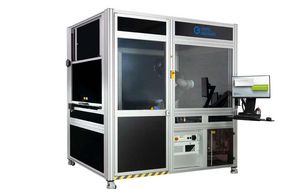New infotainment test system determines haptic key figures
Combination of robot mechanics and measuring sensors in a handling system
GÖPEL electronic has developed a new test system for the quality assurance of infotainment systems in vehicles. The special feature here is the combination of different measurement methods through the use of robots, cameras and ECU communication as well as the measurement of haptic properties.
Infotainment systems with multimedia user interfaces are complex operating and display devices for functions such as entertainment, telephony, on-board computer and vehicle settings. Car manufacturers are constantly working on redefining driving experiences through innovative operating concepts. The functional testing of such complex control units and their networking within the vehicle architecture is therefore a particular challenge in every phase of the product development process.
Up to now, complex driver information and control systems have been verified with powerful systems that have enabled a combination of electrical control unit communication, processing of camera and display data and partly mechanical operation by means of robots. The aim was always to automate the testing of the components and, in doing so, to automate the human-machine interaction. The trend towards ever-larger displays and the increased use of touch surfaces drastically reduces haptic perception for the driver with regard to localisation and the interaction of adjusters. To counteract this, haptic and sensory feedback mechanisms are used. They are intended to convey the lost mechanical information to the driver via his sense of touch. This results in a quality feature that has to be measured, which decisively determines the ergonomics, the impression of value and, of course, also the safety in the car. As a result, the possibility of objective evaluation by means of suitable measuring methods must also be available in quality assurance.
The new infotainment test system combines a robot mechanism for operating surfaces as well as the measurement sensors for forces and structure-borne sound in one handling system. The previously passive "finger" for capacitive/resistive stimulation has been replaced by a voice coil linear actuator with integrated shaft and displacement measuring device. A voice coil consists of two components: a coil on a carrier (e.g. plastic) and a cylinder with permanent magnets. The force and direction of the active part are directly dependent on the direction and strength of the current (Lorentz force). In addition, the measuring unit can be supplemented with a structure-borne sound sensor that detects possible vibrations, such as feedback signals from the touch surface. Furthermore, the robot allows combined sequences of finger and slide movements to simulate various operator scenarios, even if these involve special displays or curved displays. As a result, all functional and haptic data are available at the moment of function execution. This allows electrical parameters and image processing algorithms to be correlated with supplementary haptic classifiers.
 Demande
Demande


